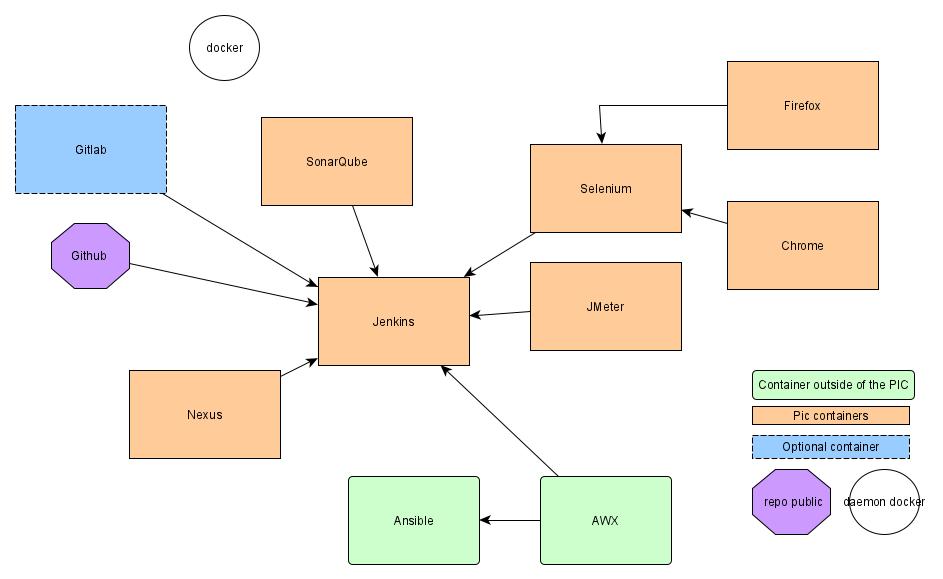(Note: Pour un environnement de production un systeme de PaaS comme Openshift ou Kubernetes est fortement conseille).
Ce repository GitHub contient des fichiers docker-compose YAML qui permettent d'executer la mise en place d'une plateforme de containers Docker qui simule un systeme de Continuous Integration et de Delivery.
Cette plateforme est disponible seulement sous Linux.
How to proceed ?
First use this file and carry on with:
if you are on Ubuntu 20.04 , read Ubuntu.md file first.
- FIRST_JOBS.md
- IntellijIDEA.mnd
- DEPLOYMENT.md
- PIPELINE_SCRIPT.md
- AWX.md
- JMETER.md
- SELENIUM.md
- PIPELINE_GUI.md
Optional: DOCKER.md
sudo yum -y update # update all packages
sudo yum -y install git wget # install git and wget
sudo yum -y install epel-release # added extra packages
sudo yum -y install htop iotop iftop # added monitoring tools
//Fork
// https://github.com/crunchy-devops/jenkins-pic.git
and git clone your personnal repository of jenkins-pic
git clone https://github.com/<your-repo>/jenkins-pic.git
cd jenkins-pic
Attention A NE PAS FAIRE les commandes suivantes, CHOISIR UNE INSTALLATION PAR ANSIBLE
L'installation de Docker necessite certains packages.
sudo yum install -y yum-utils \
device-mapper-persistent-data \
lvm2
Ensuite nous devons mettre en place le lien vers le repository Docker.
sudo yum-config-manager \
--add-repo \
https://download.docker.com/linux/centos/docker-ce.repo
Installer la derniere version de Docker et de ses packages client et containerd.io
sudo yum install docker-ce docker-ce-cli containerd.io
Lancer le daemon Docker
sudo systemctl start docker
Placer un lien symbolique pour que le daemon Docker demarre automatiquement meme si le host est reboote.
sudo systemctl enable docker
sudo yum -y install python3
# in the jenkins-pic directory
cd jenkins-pic
python3 -m venv venv # install virtualenv module dans la directory venv
source venv/bin/activate # activate the python virtualenv
pip3 install wheel # install pip package wheel for permission usage
pip3 install --upgrade pip
pip3 install ansible # install ansible
ansible --version # check, should be version 2.10.5 ansible-playbook -i inventory playbook.yml
Please log out and log in again of your shell screen for the changes take effect.
docker ps # check if docker is up and running docker run -d -p 9000:9000 --name portainer -v /var/run/docker.sock:/var/run/docker.sock portainer/portainer -H unix:///var/run/docker.sock cd jenkins-pic
source venv/bin/activate
pip3 install docker-compose # pip lib for docker-compose
pip3 install docker # pip lib for docker
docker-compose --version # check should be version 1.29.+Using the lts jenkins version, the jenkins home is a docker volume
See in the docker-compose file jenkins volume and services
Hit the command for starting up all containers
docker-compose build # build all containers
docker-compose up -d # launch all containers
docker ps # Check, 7 jenkins-pic_xxx containers should be up and runningOpen your Chrome Browser
type the URL http://<your_vm_ip_address>:18080
type docker logs jenkins-pic_jenkins_1
scroll the log file, and get the secret value
DO NOT install any plugins now, we need a fresh install
click on admin in right hand side of a screen
Hit configure
select API Token , Add new token , give jetbrains name
and Hit generate
copy this token in your notepad for later use.
change the password and confirm
go to Defined time zone. Select Europe/Paris
Press apply and save
You may get some errors so you need to login in again using your new password.
Here is an overview of all tools:
- GitLab (optional) is used for storing the Source Code.
- Github is the well-known website for archiving all your projects.
- Jenkins contains build job and is triggered once projects in GitLab are updated.
- As part of the CI build, Jenkins triggers a static code analysis and the results are stored in SonarQube.
- The Maven build uses Nexus as a Proxy Repository for all 3rd party libs. The build artifacts are deployed to the Nexus Release Repository.
- The Selenium Grid contains Docker containers running Chrome and Firefox and is used for UI tests.
| Tool | Link | Credentials |
|---|---|---|
| Jenkins | http://<vm_ip default>:18080/ | to be defined |
| SonarQube | http://<vm_ip default>:19000/ | admin/admin |
| Nexus | http://<vm_ip default>:18081/nexus | admin/use a token and set your own password |
| GitLab | http://<vm_ip default>:8080/ | defined using the console |
| Selenium Grid | http://<vm_ip default>:4444/grid/console | no login required |
| Hello-world Test | http://<vm_ip default>:8090/webapp | no login required |
| Petclinic-Test | http://<vm_ip default>:9090/petclinic | no login required |
| AWX-ansible | http://<vm_ip default> | admin/password |
